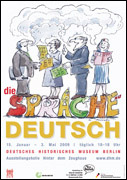


Exhibition
| Language and Language Acquisition
| History of the Language
The Art of Writing and Speaking
| Language and Technology
| The Living Language
German is the mother tongue of approx. 110 million people and belongs to the Indo-Germanic language group. It is a relatively young language and is described in sources from the Early Middle Ages as the „language of the people”. The German vernacular gained greater importance through the Reformation and the invention of printing, which promoted the development of High German.
Language changes constantly and is influenced by numerous factors. The division of Germany between 1945 and 1990, for example, brought about a politically determined transformation of the language. Numerous regional dialects exist side by side with the uniform, standardized High German. In Europe German is spoken nowadays above all in Germany, Austria and several cantons in Switzerland. In addition there are also a number of German language islands on all continents. In the EU German is the official national language of Germany, Austria and Luxembourg.
The exhibition in the German Historical Museum in Berlin, presenting a broad, thematically organized overview of the history of the German language under the title “The German Language”, is being carefully coordinated with an exhibition to take place in the Haus der Geschichte in Bonn entitled “man spricht Deutsch” ("German spoken here"), which places the accent on phenomena of the present-day German language.

Multivision - Film short 3:31 minutes
